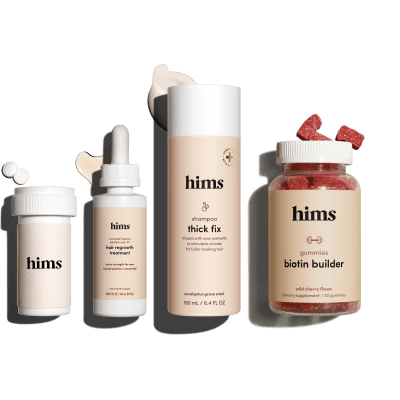Content
FDA approved for more than 25 years
Do Hair Building Fibers Really Work?

Even when it comes to covering up or disguising hair loss, you may not have heard of hair fibers. Hair fibers are colored proteins that bind to your hair and that you can apply to achieve a thicker, fuller appearance. They can work for some people in certain situations, such as when used as part of a routine for treating thinning hair.
Below, we’ve explained what hair fibers are and answered FAQs like how they work and whether or not they’re effective as part of your hair growth and hair loss prevention routine. We also share a few science-based options that you might want to consider if you’re dealing with hair loss and want to take action.
Content
What Are Hair Fibers?
Hair fibers are small keratin fibers that attach to your existing hair strands to give you the appearance of fuller, denser hair. Using a shaking container or spray applicator, you apply layers like hairspray to reduce the visibility of areas of hair thinning and other bald spots.
Hair fibers can go by a lot of names depending on the brand: hair fibers (sometimes also spelled hair fibre) or concealer, hair thickening fibers, hairline optimizer, or simply “styling products.” Brands like Toppik come in a variety of shades designed to match your natural hair type and hair color, including blonde, light brown, medium brown, dark brown, and black options, as well as some limited shades of red.
These fibers attach to your hair via a static charge — kind of like the one that builds up as you drag your feet across a wool carpet. This charge allows the hair fibers to instantly bond with your hair and stay in place when you’re, say, on a date or at the office. While not permanent, it is far less expensive — and painful — than a hair transplant.
Like other hair products, hair fibers are available at a variety of price points and quality levels. Higher quality hair fibers tend to be made of colored keratin protein, allowing them to better match the natural texture and thickness of your hair.
Since fibers bond to your real hair, they’re usually easy to apply to your hairline, crown, or other areas affected by male pattern baldness. Some colored fibers may also be useful for hiding the gray roots that can develop over time if you dye your hair.
Do Hair Fibers Work?
If you’re looking for a quick and simple solution that can make thin parts of your hair look as if they’re thicker — like how makeup can hide acne, lines, and blemishes without actually treating them — then using hair fibers as part of your routine could be a good idea.
Although research on the aesthetic effects of hair fibers is limited, one study found that both artificial fibers and natural keratin hair fibers produced good results for people with hair loss.
But if your hair care goal is to actually stop your hair from falling out — that is, fill in the thinning areas of your scalp and prevent your male pattern baldness from getting worse — then no, hair building fibers aren’t going to be effective. After all, they don’t actually stop hair loss.
Fibers don’t block DHT, a male sex hormone that, in combination with other factors, leads to male pattern baldness. Nor do they stimulate hair growth, meaning they won’t actually make your hair thicker or stop it from falling out. Instead, most hair fibers bond with your hair and simply give it the illusion of greater thickness.
Hair-building fibers are not like a conditioner either — they don’t treat hair follicles to strengthen them, nor do they address dry hair and other issues that may be affecting your hair.
It is also important to note that how much coverage hair-building fibers provide and how natural they look can vary hugely from one product to another. They work best with a short to medium-length hairstyle, and since they build on existing volume, they’re limited in what they can accomplish — even the best hair fibers can’t cover a bare crown.
more hair... there's a pill for that
Are Hair Fibers Bad For You?
While there’s no large-scale scientific research available on the side effects of using hair fibers, using them ineffectively or incorrectly could be bad for your appearance.
While some hair fibers create a natural appearance, others don’t bind well to existing hair and tend to have a fake look. One scientific case report described certain brands of hair fibers as creating a “bizarre” pattern of short, scattered hairs.
In short, the results are mixed. If you’re interested in using hair fibers, you may need to try several different brands in order to get a natural-looking hairline and scalp.
As for side effects, rare reports of itching and irritation are the exceptions to an otherwise user-friendly product.
Will you join thousands of happy customers?
4.5 average rating
Science-Based Ways to Stop Hair Loss
There are science-based options that you can use to prevent hair loss and restore your hair if you’re starting to notice the signs of baldness.
Two of the most popular treatment options on the market are finasteride and minoxidil. These are both medically-tested and FDA-approved, meaning their effectiveness at treating baldness (also known as androgenic alopecia) has been backed up by real, large-scale testing and accepted by the medical community.
Here’s a closer look at how each one works:
Finasteride: Finasteride inhibits the enzyme that converts testosterone to DHT, which lowers your DHT levels and treats hair loss.
Minoxidil: A topical medication, minoxidil moves your hair follicles into the anagen, or growth, phase of the hair growth cycle.
Hair loss treatments, delivered
Hair Fibers: The Takeaway
Hair fibers help to temporarily provide the illusion of thicker hair, but they don’t do anything to stop hair loss. While the hair fibers do disguise your hair loss, medications like finasteride and minoxidil can get to work building the biological foundation for better-looking, thicker, real human hair. As such, instead of using hair fibers as an alternative to hair loss medications, a better strategy is to use them together.
By acting early and actively treating male pattern baldness once it starts, you can maintain healthy hair growth and enjoy a dense, thick head of hair well into your 40s, 50s, 60s, and beyond.
Interested in taking action? Our selection of science-based hair loss treatments for men allows you to take control over your hair loss and start actively regrowing your hair.
8 Sources
- Badri, T., et al. (2021). Minoxidil. https://www.ncbi.nlm.nih.gov/books/NBK482378/.
- Combalia, A., et al. (2017). Scanning Electron Microscopy and X-ray Microanalysis of Reconstructive Hair Fibers. Ihttps://www.ncbi.nlm.nih.gov/pmc/articles/PMC5551306/.
- Ho, C.H., et al. (2021). Androgenetic Alopecia. https://www.ncbi.nlm.nih.gov/books/NBK430924/.
- Hu, R., et al. (2015). Combined treatment with oral finasteride and topical minoxidil in male androgenetic alopecia: a randomized and comparative study in Chinese patients. https://onlinelibrary.wiley.com/doi/abs/10.1111/dth.12246.
- Kaliyadan, F. & Feroze, K. (2018). “Hair Building” Fibers Through the Dermoscope. https://www.ncbi.nlm.nih.gov/pmc/articles/PMC6137657/.
- Kaufman, K.D., et al. (1998). Finasteride in the treatment of men with androgenetic alopecia. Finasteride Male Pattern Hair Loss Study Group. https://pubmed.ncbi.nlm.nih.gov/9777765/.
- Saed, S., et al. (2017). Hair camouflage: A comprehensive review. https://www.ncbi.nlm.nih.gov/pmc/articles/PMC5419059/.
- Zito, P.M., et al. (2021). Finasteride. https://www.ncbi.nlm.nih.gov/books/NBK513329/.
Editorial Standards
Hims & Hers has strict sourcing guidelines to ensure our content is accurate and current. We rely on peer-reviewed studies, academic research institutions, and medical associations. We strive to use primary sources and refrain from using tertiary references. See a mistake? Let us know at blog@forhims.com!
This article is for informational purposes only and does not constitute medical advice. The information contained herein is not a substitute for and should never be relied upon for professional medical advice. Always talk to your doctor about the risks and benefits of any treatment. Learn more about our editorial standards here.
Knox Beasley, MD
Dr. Knox Beasley is a board certified dermatologist specializing in hair loss. He completed his undergraduate studies at the United States Military Academy at West Point, NY, and subsequently attended medical school at Tulane University School of Medicine in New Orleans, LA.
Dr. Beasley first began doing telemedicine during his dermatology residency in 2013 with the military, helping to diagnose dermatologic conditions in soldiers all over the world.
Dr. Beasley is board certified by the American Board of Dermatology, and is a Fellow of the American Academy of Dermatology.
Originally from Nashville, TN, Dr. Beasley currently lives in North Carolina and enjoys spending time outdoors (with sunscreen of course) with his wife and two children in his spare time.
Education
Bachelor of Science, Life Sciences. United States Military Academy.
Doctor of Medicine. Tulane University School of Medicine
Training
Dermatology Residency. San Antonio Uniformed Services Health Education Consortium
Certifications
Board Certified. American Board of Dermatology
Publications
Wilson, L. M., Beasley, K. J., Sorrells, T. C., & Johnson, V. V. (2017). Congenital neurocristic cutaneous hamartoma with poliosis: A case report. Journal of cutaneous pathology, 44(11), 974–977. https://onlinelibrary.wiley.com/doi/10.1111/cup.13027
Banta, J., Beasley, K., Kobayashi, T., & Rohena, L. (2016). Encephalocraniocutaneous lipomatosis (Haberland syndrome): A mild case with bilateral cutaneous and ocular involvement. JAAD case reports, 2(2), 150–152. https://www.ncbi.nlm.nih.gov/pmc/articles/PMC4867906/
Patterson, A. T., Beasley, K. J., & Kobayashi, T. T. (2016). Fibroelastolytic papulosis: histopathologic confirmation of disease spectrum variants in a single case. Journal of cutaneous pathology, 43(2), 142–147. https://onlinelibrary.wiley.com/doi/10.1111/cup.12569
Beasley, K., Panach, K., & Dominguez, A. R. (2016). Disseminated Candida tropicalis presenting with Ecthyma-Gangrenosum-like Lesions. Dermatology online journal, 22(1), 13030/qt7vg4n68j. https://pubmed.ncbi.nlm.nih.gov/26990472/
Kimes, K., Beasley, K., & Dalton, S. R. (2015). Eruptive milia and comedones during treatment with dovitinib. Dermatology online journal, 21(9), 13030/qt8kw141mb. https://pubmed.ncbi.nlm.nih.gov/26437285/
Miladi, A., Thomas, B. C., Beasley, K., & Meyerle, J. (2015). Angioimmunoblastic t-cell lymphoma presenting as purpura fulminans. Cutis, 95(2), 113–115. https://pubmed.ncbi.nlm.nih.gov/25750965/
Beasley K, Dai JM, Brown P, Lenz B, Hivnor CM. (2013). Ablative Fractional Versus Nonablative Fractional Lasers – Where Are We and How Do We Compare Differing Products?. Curr Dermatol Rep, 2, 135–143. https://idp.springer.com/authorize?response_type=cookie&client_id=springerlink&redirect_uri=https%3A%2F%2Flink.springer.com%2Farticle%2F10.1007%2Fs13671-013-0043-0
Siami P, Beasley K, Woolen S, Zahn J. (2012). A retrospective study evaluating the efficacy and tolerability of intra-abdominal once-yearly histrelin acetate subcutaneous implant in patients with advanced prostate cancer. UroToday Int J, June 5(3), art 26. https://www.urotoday.com/volume-5-2012/vol-5-issue-3/51132-a-retrospective-study-evaluating-the-efficacy-and-tolerability-of-intra-abdominal-once-yearly-histrelin-acetate-subcutaneous-implants-in-patients-with-advanced-prostate-cancer.html
Siami P, Beasley K. (2012). Dutasteride with As-Needed Tamsulosin in Men at Risk of Benign Prostate Hypertrophy Progression. UroToday Int J, Feb 5(1), art 93. https://www.urotoday.com/volume-5-2012/vol-5-issue-1/48691-dutasteride-with-as-needed-tamsulosin-in-men-at-risk-of-benign-prostatic-hypertrophy-progression.html





